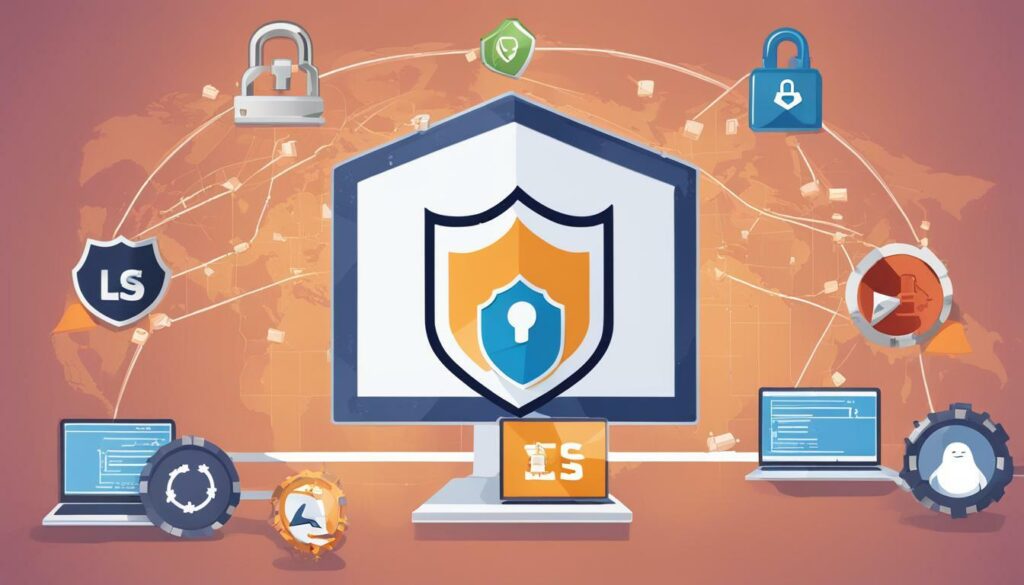If you are using a Linux server to host your website or application, it is essential to secure it with an SSL certificate. SSL certificates encrypt data transmitted between the server and clients, ensuring that sensitive information is protected from prying eyes. Fortunately, SSL certificate installation in Linux is a relatively straightforward process. In this article, we will guide you through the entire installation process, from understanding SSL certificates to testing and troubleshooting common issues.
Key Takeaways
- SSL certificate installation is crucial for securing your Linux server and protecting sensitive data.
- Understanding SSL certificates and how they work is essential before proceeding with installation.
- Preparing for SSL certificate installation involves obtaining the certificate and configuring the server.
Why SSL Certificate Installation is Crucial for Linux Servers
If you are running a Linux server, it is essential to install an SSL certificate to secure your website and protect sensitive data. SSL (Secure Sockets Layer) certificates encrypt data before it is transmitted over the internet, ensuring that sensitive information is not intercepted or compromised.
Without SSL protection, cybercriminals can easily intercept, read, and modify data transmitted between your website and users. This could include personal information, passwords, and other confidential data.
Additionally, installing an SSL certificate can improve your website’s search engine ranking and overall performance. Search engines like Google prioritize secure websites over unsecured ones, meaning that SSL certificate installation can boost your website’s visibility and credibility.
Proper SSL certificate management is also crucial for Linux servers. It is essential to regularly update and renew SSL certificates to maintain their validity and ensure continued protection.
| Key Points: | Install an SSL certificate on your Linux server to secure your website and protect sensitive data. |
|---|---|
| SSL certificates encrypt data transmitted over the internet, preventing interception and compromise by cybercriminals. | |
| SSL certificate installation can improve your website’s search engine ranking and overall performance. | |
| Proper SSL certificate management is crucial for maintaining their validity and continuing protection. |
Why SSL Certificate Installation is Crucial for Linux Servers
SSL certificate installation is not an optional step but a necessary one. Failing to install an SSL certificate could result in grave consequences, including loss of data and damage to your website’s reputation.
Fortunately, installing an SSL certificate on a Linux server is an easy process that anyone can do with some guidance. The following sections of this article will provide you with a complete guide on how to install an SSL certificate on a Linux server, along with best practices for managing and securing your SSL certificates.
Understanding SSL Certificates in Linux
If you’re running a website or web application on a Linux server, you need to ensure that your data is secure. One way to do this is by installing an SSL (Secure Sockets Layer) certificate on your server. SSL certificates are small data files that encrypt data transmitted between a server and a client, protecting it from interception or eavesdropping.
SSL certificates work by establishing a secure connection between a web server and a client’s browser. This is done through a process called “handshaking,” in which the server and client agree on a set of encryption algorithms and exchange encryption keys. Once the connection is established, data transmitted between the server and client is encrypted and secure.
When installing SSL certificates on a Linux server, it’s important to understand the various terms and concepts related to SSL certificate configuration. Here are a few key terms to keep in mind:
Public key infrastructure (PKI): A system of digital certificates, certificate authorities, and other registration authorities that verify and authenticate the validity of each party involved in an online transaction.
Certificate authority (CA): An organization that verifies and issues digital SSL certificates to entities that request them.
CSR (Certificate Signing Request): A signed request from a web server to a CA requesting a digital SSL certificate.
With these terms in mind, you’ll be better equipped to navigate the process of SSL certificate installation and configuration on your Linux server.
Preparing for SSL Certificate Installation in Linux
Before installing an SSL certificate in Linux, it is important to prepare the server and obtain the necessary materials. Below are the steps to follow for smooth installation:
- Determine the SSL certificate type: Decide which type of SSL certificate is required for the server, such as single-domain, multi-domain, or wildcard. This will depend on the number of domains and subdomains that need to be secured.
- Obtain the SSL certificate: Purchase an SSL certificate from a reputable Certificate Authority (CA) or generate a self-signed certificate. Self-signed certificates are free, but they are not viable for production websites.
- Generate a Certificate Signing Request (CSR): A CSR is required to obtain an SSL certificate from a CA. This can be done using OpenSSL, a command-line tool that is pre-installed in most Linux distributions. The CSR must include information about the server, such as the domain name, organization name, and location.
- Configure the server to use SSL: The server needs to be configured to use SSL and listen to HTTPS requests. Apache and Nginx are two popular web servers that support SSL. This involves creating a virtual host configuration file for the domain and enabling SSL in the configuration file.
By following these steps, the server will be ready for SSL certificate installation. This preparation ensures a smooth installation process and helps avoid common issues.
Step-by-Step SSL Certificate Installation in Linux
Installing an SSL certificate in Linux is a straightforward process that involves a few key steps. Here is a step-by-step guide to help you secure your website:
- Step 1: Obtain the SSL Certificate
- Step 2: Copy the Certificate Files
- Step 3: Configure the Web Server
- Step 4: Test the SSL Certificate
- Step 5: Verify SSL Certificate Installation
You can obtain an SSL certificate from a trusted Certificate Authority (CA) or generate a self-signed certificate using OpenSSL.
Copy the certificate file and the CA bundle file to the appropriate directories on your Linux server. The certificate file contains the SSL certificate for your domain, while the CA bundle file contains the public key certificates of all the CAs involved in the certificate chain.
Configure your web server to use the SSL certificate files. The specific steps for doing this depends on the web server software you are using, but generally, you will need to edit the SSL configuration file and restart the web server.
Test your SSL certificate installation to ensure that it is working correctly. You can do this by accessing your website using HTTPS and checking for the padlock icon and the “Secure” label in the browser’s address bar.
You can verify your SSL certificate installation using various online tools or OpenSSL commands. This step is optional, but it can help you ensure that your SSL certificate is properly configured and secure.
By following these steps, you can install an SSL certificate in Linux and secure your website with HTTPS. If you encounter any issues during the installation process, refer to the troubleshooting section below for guidance on how to resolve common issues.
Testing the SSL Certificate Installation
After completing the SSL certificate installation in Linux, it’s essential to verify that the certificate is functioning correctly. Fortunately, there are many tools available to test SSL certificates, including:
- OpenSSL: A command-line tool that can check SSL/TLS connections
- Qualys SSL Labs: A web-based tool that tests the SSL configuration of a website
To use OpenSSL to test your SSL certificate in Linux, run the following command:
openssl s_client -connect yourdomain.com:443
Replace “yourdomain.com” with your website’s domain name. If the SSL certificate is valid and functioning correctly, you should see a block of text that begins with “Certificate chain” and ends with “Verify return code: 0 (ok)”.
If you encounter any errors or warnings during the test, refer to the OpenSSL documentation or online resources for troubleshooting tips and solutions.
Similarly, if you choose to use Qualys SSL Labs, enter your website’s domain name into the web-based tool, and allow it to analyze your SSL configuration. The tool will provide a detailed report of your SSL certificate’s status, including any errors or warnings detected.
By testing your SSL certificate installation in Linux, you can ensure that your website is secure and protected from potential threats. Remember to periodically retest your SSL certificate to make sure it’s always up to date and functioning correctly.
Troubleshooting Common Issues in SSL Certificate Installation
SSL certificate installation in Linux servers may encounter various issues, ranging from minor errors to critical failures. Below are some common issues that users may encounter and the corresponding troubleshooting tips to resolve them.
Issue 1: Certificate Mismatch
The error message “Certificate Mismatch” indicates that the domain name on the certificate does not match the domain name of the server. This issue can be resolved by acquiring a new SSL certificate with the correct domain name or by updating the hostname of the server to match the domain name on the certificate using the “hostnamectl” command.
Issue 2: Certificate Chain Error
A “Certificate Chain Error” usually occurs when the server is unable to verify the authenticity of the SSL certificate issuer. This can be resolved by ensuring that the root certificate of the issuer is installed on the server or by acquiring a new SSL certificate from a trusted certificate authority.
Issue 3: Private Key Error
A “Private Key Error” can occur when the private key used to generate the SSL certificate does not match the private key on the server. This issue can be resolved by ensuring that the correct private key is used during the installation process or by regenerating the SSL certificate using the correct private key.
Issue 4: Certificate Expiration
An SSL certificate has an expiration date, and if it is not renewed or replaced, the server will stop serving HTTPS requests. This issue can be resolved by acquiring a new SSL certificate before the expiration date and updating it on the server or by enabling automated renewal using a certificate management tool such as Certbot.
Issue 5: Mixed Content Error
A “Mixed Content Error” can occur when the server serves both secure (HTTPS) and non-secure (HTTP) content. This issue can be resolved by ensuring that all content on the server is served securely via HTTPS, including images, stylesheets, and scripts.
By following these troubleshooting tips and solutions, users can effectively address common SSL certificate installation issues in Linux servers. However, if the issue persists or if users encounter other errors, it is recommended to consult the documentation of the SSL certificate issuer or seek assistance from a certified SSL support provider.
Best Practices for SSL Certificate Management in Linux
Once you have successfully installed an SSL certificate on your Linux server, it’s essential to keep it up to date and maintain it properly. Here are some best practices for SSL certificate management in Linux:
Certificate Renewal
SSL certificates have a limited lifespan, typically ranging from one to three years. As the expiration date approaches, it’s crucial to renew the certificate to avoid service interruptions. Most SSL providers will send a reminder when the certificate is due for renewal.
To renew the certificate, follow the same process you used for installation. Remember to update all references to the old certificate with the new one.
Certificate Revocation
In some cases, you may need to revoke a certificate before its expiration date. This could happen if the private key is compromised or if the domain name associated with the certificate changes.
To revoke a certificate, you will need to contact your SSL provider and follow their specific instructions. Once the certificate is revoked, update your server configuration to reflect the change.
Overall Maintenance
Regular maintenance of your SSL certificates will help ensure their ongoing validity and effectiveness. Here are some tips for maintaining SSL certificates in Linux:
- Monitor your SSL certificates to ensure they are up to date
- Backup your SSL certificates regularly
- Keep your server software and operating system updated to ensure compatibility with SSL encryption
- Check for any vulnerabilities in your SSL certificates or server configuration
By following these best practices for SSL certificate management in Linux, you can help ensure your server is secure and your data is protected.
Enhancing SSL Security in Linux
While SSL certificate installation provides a foundational level of security for Linux servers, there are additional measures that can be implemented to enhance SSL security. By following these techniques, you can optimize your SSL security and minimize the risk of malicious attacks.
Disable Weak Cipher Suites
Cipher suites determine the encryption algorithm and key exchange mechanisms used to secure SSL communications. However, some cipher suites are weaker than others and can compromise SSL security. Therefore, it’s essential to disable weak cipher suites in your Linux server.
Enable Perfect Forward Secrecy
Perfect Forward Secrecy (PFS) is an additional layer of security that ensures that even if the private key of an SSL certificate is compromised, previous communications are still secure. PFS can be enabled by configuring your SSL to use Diffie-Hellman (DH) key exchange.
Implement HTTP Strict Transport Security
HTTP Strict Transport Security (HSTS) is a policy that instructs web browsers to only access a website over a secure HTTPS connection, even if they attempt to connect via HTTP. By implementing HSTS, you can prevent vulnerabilities that arise from users inadvertently accessing your website via non-secure HTTP channels.
Use Extended Validation (EV) Certificates
EV certificates provide the highest level of SSL security and validation. With an EV certificate, the certificate authority (CA) performs a rigorous validation process to ensure that the organization is legitimate and has a legal right to use the domain name. When using an EV certificate, users can be confident that they are communicating with a trusted organization and not an imposter.
Regularly Monitor and Update SSL Configuration
As with any security protocol, it’s essential to regularly monitor and update your SSL configuration to address potential vulnerabilities and stay current with the latest security best practices. By monitoring your SSL configuration, you can detect and resolve security issues before they become major problems.
Keeping SSL Certificates Up to Date in Linux
Regular updates of SSL certificates are essential to ensure the continued security of your Linux servers. It is crucial to stay informed about upcoming expiration dates, renewal procedures, and best practices for certificate management.
One effective way to keep SSL certificates up to date is to set up automated renewal processes. This can be achieved by using tools like Certbot or Let’s Encrypt, both compatible with Linux servers, which automatically renew certificates before they expire. By automating this process, you can save time and ensure your certificates remain valid.
Another recommended practice is to keep track of upcoming certificate expirations using a reliable monitoring tool like Nagios or Icinga. These tools provide notifications of upcoming certificate expirations, allowing you to renew your certificates promptly.
Conclusion
Keeping SSL certificates up to date is an essential aspect of Linux server security. By regularly updating certificates, automating renewal processes, and monitoring expiration dates, you can maintain the robust data protection your organization needs. Make sure to follow best practices for certificate management and stay informed about any changes in SSL technology to keep your Linux servers secure.
Conclusion
SSL certificate installation is a critical step in protecting your Linux server and ensuring secure online transactions. By following the step-by-step guide provided in this article, you can install and test an SSL certificate with ease, as well as troubleshoot any issues that may arise during the process.
Remember to keep your SSL certificates up to date and practice good certificate management, such as renewal and revocation, to ensure continued security. Implementing additional security measures alongside SSL certificate installation can further enhance the protection of your Linux server.
Don’t neglect the importance of SSL certificate installation in Linux. Take action now to safeguard your server and keep your data secure.
FAQ
Q: Why is SSL certificate installation crucial for Linux servers?
A: SSL certificate installation is essential for Linux servers because it provides data protection and secures online transactions. It encrypts information transmitted between the server and the user, preventing unauthorized access and ensuring confidentiality.
Q: What are SSL certificates and how do they work in Linux?
A: SSL certificates are digital certificates that verify the identity of a website or server and establish a secure connection. In Linux servers, SSL certificates are used to encrypt data and facilitate secure communication between the server and users. They leverage cryptographic algorithms to ensure data integrity and privacy.
Q: What preparations are required for SSL certificate installation in Linux?
A: Before installing an SSL certificate in Linux, you need to obtain the certificate from a trusted certificate authority (CA) and configure your server to support SSL. This may involve generating a certificate signing request (CSR) and configuring the server software to enable SSL/TLS protocols.
Q: How can I install an SSL certificate in Linux?
A: To install an SSL certificate in Linux, follow these step-by-step instructions:
1. Copy the certificate files to the server.
2. Configure the server software to use the certificate.
3. Verify the installation by testing the SSL connection.
4. Adjust firewall settings if necessary.
5. Regularly update and renew the SSL certificate to maintain security.
Q: How can I test the SSL certificate installation in Linux?
A: Testing the SSL certificate installation in Linux involves using various tools to verify the certificate’s validity and confirm that the encrypted connection is functioning correctly. Tools like OpenSSL can be used to check the certificate chain, cipher suites, and overall SSL/TLS configuration.
Q: What are some common issues that may arise during SSL certificate installation in Linux?
A: Common issues during SSL certificate installation in Linux may include incorrect file permissions, misconfigured server software, compatibility issues with certain browsers or devices, and certificate chain validation errors. Troubleshooting tips and solutions can help resolve these issues.
Q: What are some best practices for SSL certificate management in Linux?
A: To effectively manage SSL certificates in Linux servers, it is recommended to:
1. Keep track of certificate expiration dates and renew them in a timely manner.
2. Use a centralized certificate management system for easy tracking and renewal.
3. Regularly check for certificate revocation or updates.
4. Keep server software up to date to address any vulnerabilities.
Q: How can I enhance SSL security in Linux?
A: In addition to SSL certificate installation, enhancing SSL security in Linux servers can be achieved by implementing measures such as enabling perfect forward secrecy (PFS), using secure ciphers, disabling insecure protocols, and implementing web application firewalls and intrusion prevention systems.
Q: How do I keep SSL certificates up to date in Linux?
A: Keeping SSL certificates up to date in Linux involves regularly monitoring certificate expiration dates, setting up reminders or alerts for renewal, and staying informed about the latest industry practices and recommendations for SSL certificate management. It is important to proactively manage SSL certificates to ensure uninterrupted security.





